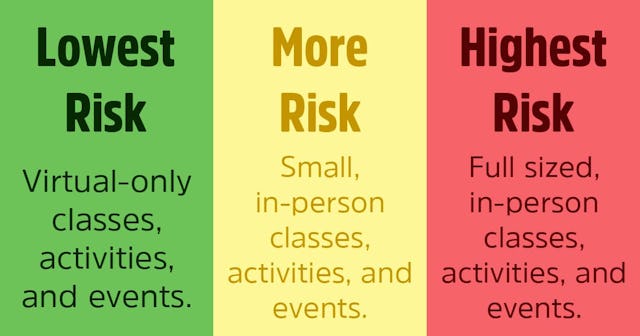Here Are The CDC's Guidelines For The Safe Opening Of Schools

The CDC has released their recommendations and guidelines for safely reopening schools during the COVID-19 pandemic
Ever since schools began closing in mid-March due to the COVID-19 pandemic, questions have swirled about the reopening of schools. When will they be able to safely open, what measures will schools have to take in order to ensure the safety of students, and what will an average day at school entail in a pandemic world? This week, the Centers for Disease Control and Prevention released their suggested guidelines for school reopenings.
“As some communities in the United States open K-12 schools, CDC offers the following considerations for ways in which schools can help protect students, teachers, administrators, and staff and slow the spread of COVID-19,” the CDC explains. Ultimately, it will be up to the schools “in collaboration with state and local health officials to the extent possible,” not only when it is safe to open, but how to implement the recommendations made by the organization.
“Implementation should be guided by what is feasible, practical, acceptable, and tailored to the needs of each community,” they continue. “These considerations are meant to supplement—not replace—any state, local, territorial, or tribal health and safety laws, rules, and regulations with which schools must comply.”
The CDC goes on to note that the “more people a student or staff member interacts with, and the longer that interaction, the higher the risk of COVID-19 spread,” pointing out that the “spread increases in school settings.” The lowest risk, unsurprisingly, is when students and teachers engage in virtual-only classes, activities, and events. A riskier scenario?
“Small, in-person classes, activities, and events. Groups of students stay together and with the same teacher throughout/across school days and groups do not mix. Students remain at least 6 feet apart and do not share objects (e.g., hybrid virtual and in-person class structures, or staggered/rotated scheduling to accommodate smaller class sizes).” And of course, the highest risk involves going back to “normal.” “Full sized, in-person classes, activities, and events. Students are not spaced apart, share classroom materials or supplies, and mix between classes and activities.”
An important part of keeping COVID-19 out of schools is via “personal prevention practices” including hand-washing, staying home when sick, and also environmental cleaning and disinfection. “Schools may consider implementing several strategies to encourage behaviors that reduce the spread of COVID-19,” they remind. Staff and students should stay home if they have tested positive for the virus, show any symptoms, or recently had close contact with a person with it.
The CDC also recommends the use of face coverings. “Teach and reinforce use of cloth face coverings,” they write. “Face coverings may be challenging for students (especially younger students) to wear in all-day settings such as school. Face coverings should be worn by staff and students (particularly older students) as feasible, and are most essential in times when physical distancing is difficult.” They do note that face coverings should not be placed on children under 2, anyone who has trouble breathing or is unconscious, anyone who is incapacitated or otherwise unable to remove the cloth face covering without assistance.
When it comes to frequently touched surfaces — from playground equipment to drinking fountains — they suggest cleaning and disinfecting frequently. “Use of shared objects (e.g., gym or physical education equipment, art supplies, toys, games) should be limited when possible, or cleaned between use,” they explain. Buses should also follow the same hygiene and cleaning guidance,
The sharing of items that are difficult to clean — ranging from toys and books to art supplies — should be discouraged, with each child having their own cubby or space for personal items.
As for social distancing, the CDC encourages spacing out seating/desks in the classroom 6 feet apart. “Turn desks to face in the same direction (rather than facing each other), or have students sit on only one side of tables, spaced apart,” they write. The same goes for the school bus. “Create distance between children on school buses (seat children one child per row, skip rows) when possible.” If it is too difficult to remain apart, they suggest installing “physical barriers, such as sneeze guards and partitions,” or physical guides (such as tape on floors or sidewalks and signs on walls.)
Another way to keep contact at a minimum is by keeping the same group of students with the same staff (all day for young children, and as much as possible for older children), limit mixing between groups if possible, and maintaining staggered scheduling. “Stagger arrival and drop-off times or locations by cohort or put in place other protocols to limit contact between cohorts and direct contact with parents as much as possible,” they advise.
As for shared communal spaces –including the playground and cafeteria — the CDC recommends closing them “if possible; otherwise, stagger use and clean and disinfect between use.”
They also suggest children bringing their own meals “as feasible, or serve individually plated meals in classrooms instead of in a communal dining hall or cafeteria, while ensuring the safety of children with food allergies,” using disposable food service items.
Physical group events, gatherings, field trips, assemblies, performances, spirit nights, and meetings, are discouraged. Instead, they suggest virtual events.
To read more about the CDC’s recommendations, visit their website. Do not trust third-party infographics being posted on social media, which may not be completely accurate.